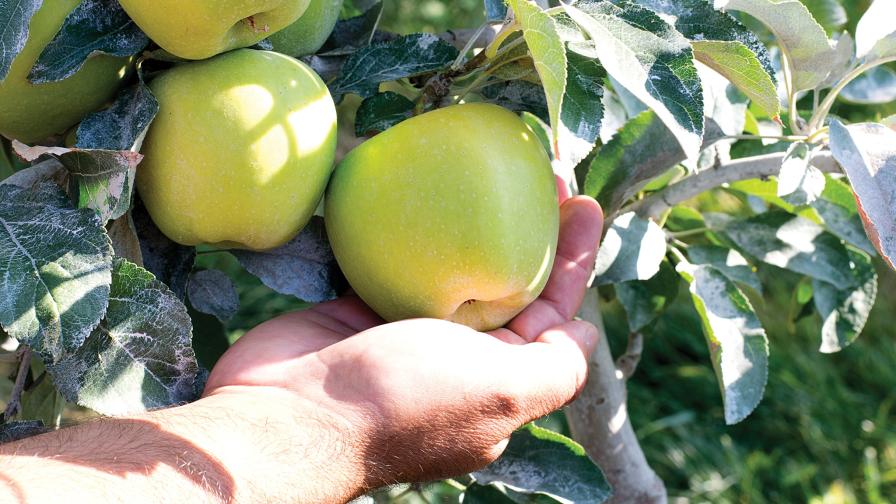Seeing The Positives In Brown Marmorated Stink Bug Invasion
 Brown marmorated stink bug. Ugly name, ugly insect, ugly implications for American agriculture. No-so-affectionately known as BMSB, the pest was first identified in Eastern Pennsylvania in 2001, where it quickly became a smelly, scurrying, obnoxious nuisance inundating homes, offices, and warehouses.
Brown marmorated stink bug. Ugly name, ugly insect, ugly implications for American agriculture. No-so-affectionately known as BMSB, the pest was first identified in Eastern Pennsylvania in 2001, where it quickly became a smelly, scurrying, obnoxious nuisance inundating homes, offices, and warehouses.
By 2010, however, BMSB spread geographically and transmogrified into more than a mere annoyance when outbreaks throughout the Mid-Atlantic States resulted in millions of dollars in damage to specialty crops, often causing 100% losses in tree fruits and vegetables.
The onslaught has continued, with BMSB now reported in 41 states and two Canadian provinces. Building on its negative charisma, the invader even has its very own website, StopBMSB.org, developed as part of a USDA Specialty Crop Research Initiative (SCRI) project led by Tracy Leskey, USDA-ARS, Kearneysville, WV, and maintained by the Northeastern IPM Center.
Regulations Help Protect Crops
Such imported invasive pests and diseases have always been a paramount concern for American crop and forestry industries. Invasive pests like Chestnut blight and Japanese beetle were recognized more than 100 years ago and our federal and state regulatory agencies have adopted regulations to protect American agriculture and attempt to eliminate, or at least mitigate, similar threats to the security of our crops, livestock, and forests. Check out HungryPests.com.
The regulatory approach has generally been successful, if often irritating and costly to tree fruit producers who want to import trees or propagation material. Just look at the recent victory tree fruit growers in the Northeast have achieved controlling the spread of plum pox.
Well, that is one victory for the good guys, but globalized trade has ratcheted up the risk invasive pests pose. In the past 10 to 20 years, consider an abbreviated list of newly introduced pests: Asian longhorned beetle, emerald ash borer, spotted wing drosophila, European grapevine moth, Asian citrus psyllid, and various fruit flies.
Some of those have brought considerable and sustained economic distress at local and regional levels, Asian citrus psyllid and citrus greening, for example, are genuine catastrophes. Others, like spotted wing drosophila, are significant but controllable problems.
The Bad News
When it comes to tree fruit and many other specialty crops, BMSB probably falls into the catastrophic category, moving from nuisance to severe agricultural pest status as it radiates from ground zero in Pennsylvania, its progress seemingly undeterred by unfavorable environments or natural enemies.
Luckily, BMSB SWAT teams of researchers and Extension professionals have come up with crop protection programs utilizing commercially available pesticides to keep tree fruit producers in business. But it’s come at a considerable cost: the near dismantling of heretofore successful Integrated Pest Management (IPM) programs. This fundamentally threatens the sustainability of insect management programs for many specialty crops.
As the BMSB website puts it: “broad-spectrum sprays also kill beneficial insects that help to control pest populations, presenting a setback for growers who use integrated pest management to promote nature’s own checks and balances on their farms. In addition, the risk of pest resistance increases with greater use of chemical products.”
This is nothing but bad news for tree fruit producers and their IPM programs. It is also bad news for members of the research and Extension community, who have devoted their careers transitioning us from the old days of the nuclear option to effective and sustainable approaches tailored to specific production areas. Pretty depressing.
Now For The Good News
Perhaps I’m guilty of unreasonable optimism, but I see two glimmers of good news.
The first is the fact that we have something to lose! Not too many years ago, IPM was often considered an academic, impractical exercise. Now, it is standard operating procedure, and some dare to dream that a zero-residue program is possible. What a tribute to those entomologists whose vision continues to transform an entire industry’s crop protection practices. BMSB, while nothing to celebrate, does place in high relief the progress we have made to protect our tree fruit crops more effectively and sustainably.
The second glimmer is about people, particularly two entomologists who provide me the confidence that BMSB, like other pests we have faced, will not bring Arthropod Armageddon.
Researchers Making A Difference For You
The first is Jay Brunner, a scientist at Washington State University, whose entire career has been devoted to creating a sound scientific base to develop practical, grower-friendly IPM programs. Jay is about to retire with a well-earned opportunity to work on his golf game. He can do so knowing his pioneering work on pheromone-based mating disruption to control codling moth, along with his many other professional contributions, was critical to establishing IPM in Western U.S. tree fruit industries. Ironically, Jay has also done considerable work on stink bugs, and is part of the BSMB-SCRI project, which started in 2011.
That second entomologist is the leader of the SCRI project, Tracy Leskey, an early career scientist who will no doubt make the kind of contributions Jay has made. Already, Tracy and the 50 other researchers representing 10 U.S. institutions in the project have developed a better scientific knowledge base and accompanying chemical, cultural, biological, and management tools to deal with BMSB over the long haul.
Pests like BMSB are nothing to celebrate, and have made life miserable for so many specialty crop producers, but behind that ugly insect is a story of hope. With leaders like Jay and Tracy, and the many scientists working alongside, tree fruit growers will be able to maintain their commitment to the principles and practices of Integrated Pest Management.










